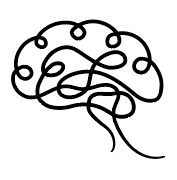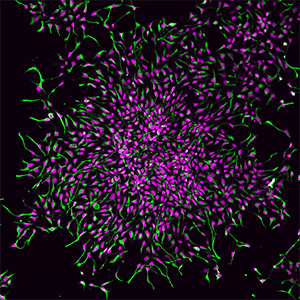It is well known that the regenerative potential of somatic stem cells declines with age. Ageing of neural stem cells (NSCs) in mice is not only controlled by an intrinsic program but also by extrinsic factors present in the niche. Although it is not fully understood how the extrinsic signals are integrated, NSCs seem to be protected from depletion by an increase in quiescence over time.
Deciphering the molecular network of NSC decline and gain of quiescence is key to understanding the regenerative processes in the adult brain, however, experimental access to human young and old NSCs is understandably limited. Reprogramming technology provides an irreplaceable experimental basis to access human neural cells of a distinct age. Epigenetic and transcriptional ageing signatures are erased by reprogramming of human fibroblasts to induced pluripotent stem (iPSC) cells. This rejuvenation process, however, does not occur during direct conversion into induced neurons (iN) since they largely maintain the ageing profile of the starting fibroblast population.
The Edenhofer group at the University of Innsbruck, aims to understand intrinsic and extrinsic determinants of human NSC identity overtime. We are establishing a rejuvenation/reprogramming atlas by global assessment of epigenetic and transcriptional ageing profiles of human isogenic iNSCs, iNs, iPSCs, iPSC-derived NSCs and their parental fibroblasts. Additionally, we will comprehensively assess reprogramming trajectories during direct conversion of human fibroblasts into iNSCs by serial combinatorial cell-indexing. This will enable parallel capture of clonal history and cell identity to reconstruct multilevel lineage trees.
How are extrinsic signals integrated into intrinsic programs controlling humans NSC identity? We will investigate the roles of candidate genes such as the MYC genes, which function as important regulators in NSCs to convert microenvironment signals into cell cycle control. We will experimentally test this by generating conditional genetic loss-of-function models in human NSCs.
How are intrinsic signals communicated contributing to the remarkable specializations of the human brain? We will use a genome-wide screen to decipher the complex regulatory interactions of a set of genes preferentially expressed at early human nervous system development that were identified following a comparative transcriptomic analysis of human and non-primate brains. This will help us determine how they control NSC type diversity and responses to extrinsic signals such as BMP and inflammatory IFNs at single cell resolution.
Our work will help deepen our understanding of human brain development and foster the use of different types of NSCs in disease modeling and cell therapy strategies.


Add Your Comment